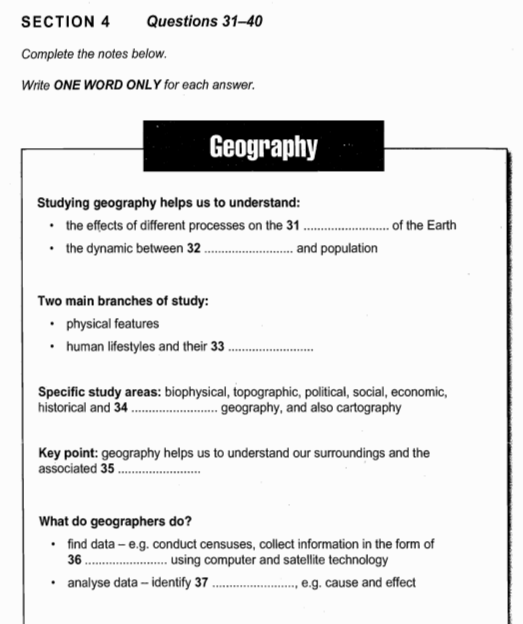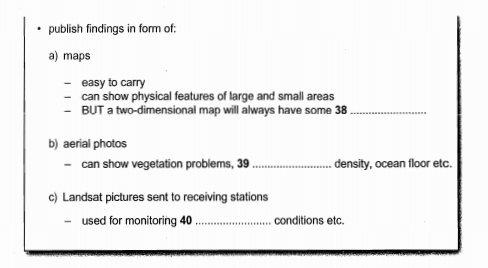剑桥雅思8听力:Test1雅思听力Section4真题及解析
发布时间:2020-11-18 关键词:SECTION 4
So, welcome to your introductory geography lecture. We'll begin with some basics. Firsty,what do we learn by studying geography?
Well, we learm a great deal about all the processes that have affected and that oontinue toaffect the earth's surface. But we learn far more than that, because studying geographyalso informs us about the dffrent kinds of relationships that develop between a particularenvironment and the people that live there.
Okay. We like to think of geography as having two main branches, There's the study of thenature of our planet - ils physical features, what it acdually looks like - and then there's thestudy of the ways in which We choose to live and of the impact of those on our planet. Ourcurrent use of carbon fuels is a good example of that.
But there are more specific study areas to consider too, and well be looking at each ofthese in turn throughout this semester. These inlude bio-physical geography, by which Imean the study of the natural environment and all its living things. Then there's topography- that looks at the shapes of the land and oceans. There's the study ol ollial geographyand s0cial geography too, of course, which is the study of communities of people. We haveeconomic geography - in which we examine all kinds of resources and their use -
agriculture, for example. Next comes historical geography - the understanding of howpeople and their environments and the ways they interact have changed over a period oftime - and urban geography, an aspect I'm partiularly interested in, which takes as its
focus the location of cities, the services that those cities provide, and migration of people toand from such cities. And lastly, we have cartography. That's the art and science of map-making. You'll be doing a lot of that!
So, to summarise before we continue, we now have our key answer .... studying thissubject is important because without geographical knowledge, we would know very litllabout our surroundings and we wouldn't be able to identify all the problems that relate tothem. So, by defnition, we wouldn't be in an informed position to work out how to solve anyof them.
Okay, now for some pracdicalities. What do geographers actually do? Well, we ollect datato begin with! You'll be doing a lot of that on your first field trip! How do we do this? Thereare several means. We might, for example, conduct a census - count a populationin aglven area perhaps. We also need images of the earth's surface which we can produce bymeans of computer-generation tochnology or with the help of satellte relays. We've come avery long way fom the early exploration of the world by saling ships when geographersonly had pens and paper at their disposal.
After we've gathered our iformation, we must analyse i! We need to look for attemns,most commonly those of causes and consequences. This kind of infomation helps us topredict and resolve probiems that could affect the worid we live in.
But we don't kep all this iformation confdental. We then need to publish our findings sothat other people can access it and be infomed by iL And one way in which this informationcan be published is in the form of maps. You'l all have used one at some stage of your lifealready Let's consider the benefis of maps from a geographer's perspective.
Maps can be folded and put in a pocket and can provide a great store ol reference whenthey're ollecded into an atlas. They can depicl the physical features of the entire planet ifnecessary, or, just a small part of it in much greater detail. But there is a drawback, Youcan't exacl replicate something that is three-dimenskonal, like our planet, on a fiat piece ofpaper, because paper has only two dimensions, and that means there'll always be a certaindegree of distortion on a map. It can't be avoided.
We can also use aerial photographs .... pictures taken by cameras at high altitutde abovethe earth. These are great for showing all kinds of geographical featurs that are not easyto see from the ground. You can easily ilsrt areas of diseased trees or how muchraffic is on the roads at a given time or infomation about deep sea beds, for example.Then there are Landsats. These are stellites that circle the earth and transmit visualinformation to computers at receiving stations. They cirdle the earth several times a dayand can provide a mass of ifomation - you'll all be familiar with the information they giveus about the weather, for example.
So, what we're going to do now is look at a short presentation in which you'll see all thesetools ...
第 4 节
所以,欢迎参加您的地理介绍性讲座。我们将从一些基础知识开始。首先,我们学习地理学什么?
嗯,我们大谈所有影响的过程,以及影响地球表面的过程。但是,我们学到的远不止于此,因为学习地理学也告诉我们特定环境与生活在那里的人之间发展的各种关系。
好。我们喜欢把地理视为有两个主要分支,研究我们星球的时貌——自然特征,它通常是什么样子——然后研究我们选择的生活方式,以及这些对地球的影响。我们目前对碳燃料的使用就是一个的例子。
但也有更具体的学习领域需要考虑,并地研究每一个反过来在整个学期。这些不分自然的生物物理地理,通过伊米安研究自然环境及其所有生物。然后是地形,它看陆地和海洋的形状。当然,还有研究是种族地理和地理地理,这是对人社区的研究。我们有经济地理学 - 我们检查各种资源及其用途 -
农业,例如。接下来是历史地理——对人及其环境的理解,以及他们在一段时间内互动的方式——和城市地理,我对此感兴趣, 这一方面作为它
重点定位城市的位置、这些城市提供的服务以及人们向这些城市迁移和迁移。最后,我们有制图。这就是地图制作的艺术和科学。你会做事的!
因此,在继续之前,要总结一下,我们现在有我们的关键答案。...研究这个主体很重要,因为没有地理知识,我们就会了解周围的环境,我们无法确定与它们相关的所有问题。因此,通过防御,我们不可能在知情的位置上找出如何解决它们中的任何一个。
好了, 现在为了一些练习。地理学家实际上做什么?好吧, 我们先选择数据!你次实地考察时会做事!我们如何做到这一点?有几种方法可以。例如,我们可以进行人口普查——也许可以统计一个在一个格文地区的人口。我们还需要地球表面的图像,我们可以通过计算机代托克学或借助卫星继电器来生成这些图像。当地理学家们拥有钢笔和纸时,我们通过救船来探索世界,已经走很长的路。
在我们收集了信息之后,我们必须分析我!我们需要寻找原因和后果。这种信息有助于我们预测和解决可能影响我们生活中的那些可怕的问题。
但是,我们并不想把这一切混为一谈。然后,我们需要发布我们的发现,以便其他人可以访问它,并由 iL 提供信息,发布此信息的一种方式是地图的形式。你们都在人生的早期阶段都用过地图,让我们从地理学家的角度考虑地图的恩菲。
地图可以折叠起来放在口袋里,当它们被装入地图册时,可以提供的存储参考。如果必要的话,它们可以降低整个星球的物理特性,或者,只是其中的一小部分更加详细。但有一个缺点,你不能像我们的星球一样,在一张纸上复制出三维的东西,因为纸只有两个维度,这意味着地图上总会有程度的失真。避免不了
我们也可以用航拍。高海拔地区的照相机拍摄的照片。这些是伟大的显示各种地理特征,不容易看到从地面。例如,你可以很容易地找到患病树木的区域,或者在给定时间道路上有多少流量,或者关于深海海床的信息。还有陆地卫星。这些是环绕地球并将视觉信息传送到接收站的计算机的星。它们每天绕地球好几次,可以提供大量的信息——例如,你将会熟悉它们给我们的关于天气的信息。
所以,我们现在要做的是看一个简短的演示,你会看到所有这些工具…


Question 31 答案 surface
听前预测 :定位词为effects of different processes,提示词为 on the,本题应填名词。 题目解析 :本题为信息后置,出题句为 We learn a great deal about all the processes that have affected and that continue to affect the earth’s surface.(我们学习一些变化的过程,这些过程已 经影响或继续影响地球的表面。)
Question 32 答案 environment
听前预测 :定位词为 dynamic、population,提示词为 between...and...,本题应填名词。 题目解析:本题有点难度,出题句为 But we learn far more than that, because studying geography also informs us about the different kinds of relationships that develop between a particular environment and the people that live there. 其中 different kinds of relationships 对应题干中的 dynamic,people that live there 对应题干中的 population。解题时要注意以下两点:(1) 字数要求为 ONE WORD ONLY ;(2)并列结构词为 also,与 31 题为并列关系。
Question 33 答案 impact(s) / effect(s)
听前预测 :定位词为 main branches、physical features、human lifestyles,提示词为 and,本题 应填名词或名词性短语。 题目解析 :根据定位词找到本题的大致出题句,重点关注并列连词 and,题干中的 human lifestyle 对应原文中的 the ways in which we choose to live,故 impact 为本题答
案。
Question 34 答案 urban
听前预测 :定位词为 biophysical、topographic、political、social、economic、historical,提示词为 and,本题应填形容词。 题目解析 :本题难度不大,所听即所得,注意之前出现的一系列并列关系的定位词,很快能听 到 urban 为本题答案。
Question 35 答案 problems
听前预测 :定位词为 understand our surroundings,提示词为 associated,本题应填名词。题目解析 :本题难度不大,定位容易,出题句为 because without geographical knowledge, we would know very little about our surroundings and we wouldn’t be able to identify all the problems that relate to them.(因为没有地理知识的话,我们就无法了解我们的环境,我们也无法发现与 之相关的问题。)特别注意该题答案为复数形式。
Question 36 答案 images
听前预测 :定位词为 conduct censuses,提示词为 the form of,本题应填名词。 题目解析 :本题难度不大,注意答案为复数形式。根据题干定位词,很容易找到出题句,同时 注意利用并列关系连接词 also,听清文章层次。
Question 37 答案 patterns
听前预测 :定位词为 analyse data,提示词为 identify,本题应填名词。 题目解析 :本题难度不大,注意答案为复数形式。出题句为 We need to look for patterns, most commonly those of causes and consequences.(我们需要寻找模式,特别是原因和结果。)
Question 38 答案 distortion(s)
听前预测:定位词为two-dimensional map,提示词为some,本题应填名词(复数)。题目解析:根据题干定位词,本题出题句为 ...because paper has only two dimensions, and that means there’ll always be a certain degree of distortion on a map.(因为纸张仅仅是二维的,所以 通常在地图上会有程度的扭曲。)由于题干中有 some,所以本题答案可以写成复数形式。
Question 39 答案 traffic 听前预测 :定位词为 aerial photos、vegetation problems,提示词为 density,本题应填名词或
形容词。
题目解析 :本题出题句为 you can easily illustrate areas of diseased trees or how much traffic is on the roads at a given time or information about deep sea beds. 其中 diseased trees 对应题干中 的 vegetation problems,故本题答案为 traffic。
Question 40 答案 weather
听前预测 :定位词为 landsat pictures,提示词为 conditions,本题应填名词或形容词。 题目解析 :本题难度不大,容易定位,注意信息后置,出题句为 you’ll all be familiar with the information they give us about the weather. 核心名词 weather 为本题的答案,注意该词的拼写。




